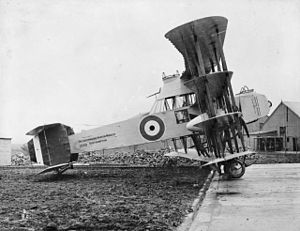Supermarine Nighthawk
| P.B.31 Nighthawk | |
|---|---|
 |
|
| Supermarine Nighthawk | |
| Role | Anti-Zeppelin fighter |
| National origin | United Kingdom |
| Manufacturer | Supermarine |
| First flight | 1917 |
| Status | Prototype only |
| Number built | 1 |
| Developed from | Pemberton Billing P.B.29E |
The P.B.31E Nighthawk, the first project of the Pemberton-Billing operation after it became Supermarine Aviation Works Ltd., was a prototype anti-Zeppelin fighter with a crew of three to five and an intended endurance of 9–18 hours. It was first flown in February 1917 with Clifford Prodger at the controls.
The Nighthawk had six-bay swept quadraplane wings and a biplane tailplane with twin fins and rudders. The fuselage filled the gap between the second and third wings; the cockpit, which carried up to the top wing "turret", was enclosed and heated.
Along with the intended long endurance, it was suggested it would be able to patrol at low speeds and await the Zeppelin. For armament, it had a trainable nose-mounted searchlight, a 1½-pounder (37 mm) Davis gun mounted above the top wing with 20 shells, and two .303 in (7.7 mm) Lewis guns. Power for the searchlight was provided by an independent petrol engine-driven generator set made by ABC Motors, possibly the first instance of a recognisable airborne auxiliary power unit.
Although touted as being able to reach 75 mph (121 km/h), the P.B.31E prototype only managed 60 mph (97 km/h) at 6,500 ft (1,981 m) and took an hour to climb to 10,000 ft (3,048 m), which was totally inadequate for intercepting Zeppelins. Given the Anzani engine's reputation for unreliability and overheating, it is unlikely that the aircraft would have delivered the advertised endurance either.
Data from The British Fighter since 1912
General characteristics
Performance
Armament
...
Wikipedia
